If seeing wildlife on vacation lights you up like a pooch with a new ball, then Patagonia is a must-visit travel destination. Seeing fauna in the wild is a gift to any traveller. Seeing it against a backdrop of Patagonia’s spectacular landscapes takes the experience to a whole other level.
Covering South America’s southernmost region, Patagonia straddles Chile and Argentina. A stunning destination filled with craggy mountains, untamed plains and an otherworldly desert, the region’s natural beauty is unrivalled. This becomes even more apparent when explored by boat and on foot, as you get closest to the most fascinating animals of Patagonia, including land and marine mammals, birds and reptiles.
Read on to discover what exciting animals in Patagonia you might spot while travelling with Aurora Expeditions.
On The Land
Wow. There really are some impressive Patagonia animals that roam this wild and untamed land. From majestic predators like the puma to enchanting encounters with creatures including the guanaco and Darwin’s rhea, expect to get close to creatures and critters unlike anywhere else on earth.
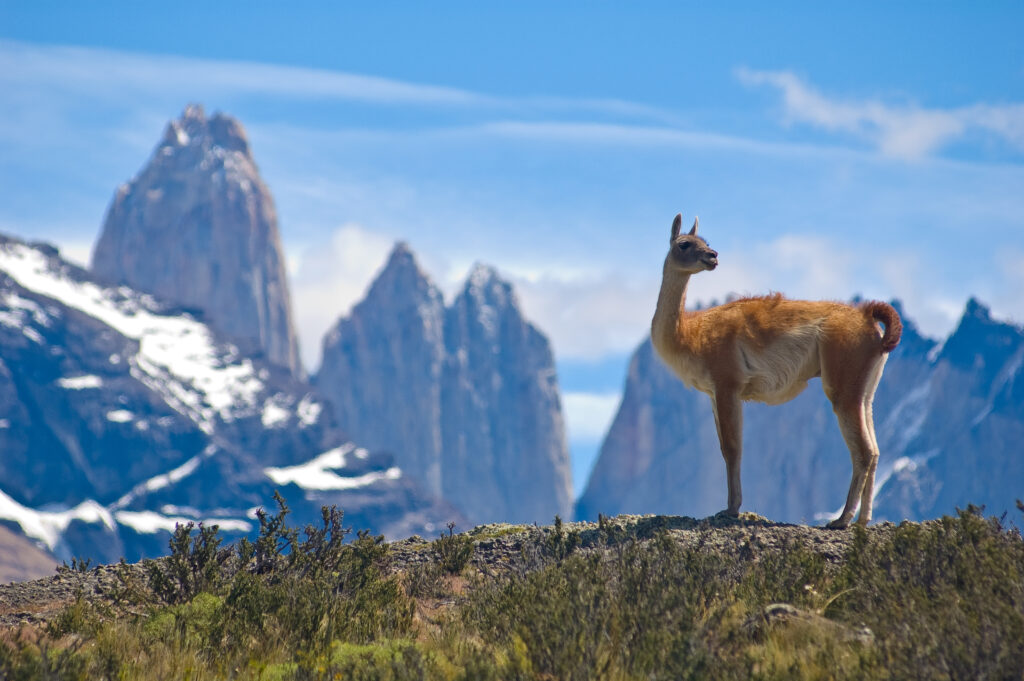
Glimpse graceful guanacos
Seeing a guanaco roaming Patagonia’s open plains is a thrilling experience, a sighting that offers a true sense of where you are in the world. A leaner relative of the llama and alpaca, the guanaco is a wild camelid that carries itself with elegance and dexterity. Sightings are common on our Patagonia and Chilean Fjords tour, with groups of female guanacos (usually with a token male) often being spotted in the Torres del Paine National Park. Young guanaquitos are renowned for producing soft and luxurious wool. However, as with all fauna encountered on our expeditions, don’t get too close to guanaco or their young – the guanaco’s fierce spit is the first sign that it’s agitated!
If you spot a similar-looking, smaller ungulate with a light rusty-coloured, softer coat, that’s a vicuña. These shy, graceful runners are usually about half the size of their guanaco cousins and tend to be more solitary.
Pro tip: if you’re not sure if you’re seeing a guanaco or vicuña, check your altitude! These South American animals both live at elevation, however vicuñas typically live 6,000 metres (20,000 feet) above sea level, while guanacos hang at lower elevations.
Get doe-eyed at Patagonia’s deer
There are two types of deer to spot in Patagonia – huemul and pudu – though it’s the latter that melts even the most hardened of hearts. The world’s smallest deer triggers an aww-response, especially when a mother blurts a soft “moo” to her baby. Should you encounter a pudu in the wild, our experienced Expedition Team will do everything they can to ensure this endangered mini deer isn’t alarmed. When threatened, it trembles, hair on end, and its lacrimal glands open giving the appearance of tears. We can confidently say that if you witnessed this, you would be in tears yourself!
The elusive huemul deer is also endangered. Found on rocky slopes and mountain passes, this stocky, short-legged deer is a Chilean National Natural Monument, meaning the species is protected and receives vital funding. They can often be spotted around Lago Grey in Torres del Paine or Aysén’s Patagonia Park.
Go wild for wildcats
You don’t need to be a cat lover to experience the thrill of seeing one of Patagonia’s more elusive land mammals on your travels! Also known as the mountain lion or cougar, pumas – typically travelling solo – are adept at stealth as they roam the southern region of Patagonia. Pumas hunt for small mammals and ungulates, including some of our friends from earlier – namely the guanaco and vicuña.
As there is a healthy population of pumas in Torres del Paine National Park, a trekking trip there gives a better chance of seeing these beautiful big cats in the wild, especially if you’re alert at dusk and dawn! You can spot pumas in Los Glaciares National Park and Tierra del Fuego, too. The latter’s forest, peat bogs and coastal areas combine to make the perfect habitat for pumas. With no wolves or bears in Patagonia, pumas are one of the biggest predators out there.
Besides the puma, there are other wildcats that call Patagonia home, such as the Andean mountain cat, and Geoffroy’s cats – also known as fishing cats – found in Argentine Patagonia. Geoffroy’s cats are South America’s smallest wild cat, not dissimilar to your cat at home. These wild cats search the shrublands and lowland grassy pampas for tasty morsels, including rodents, frogs, armadillos and – you can guess from their nickname – fish!
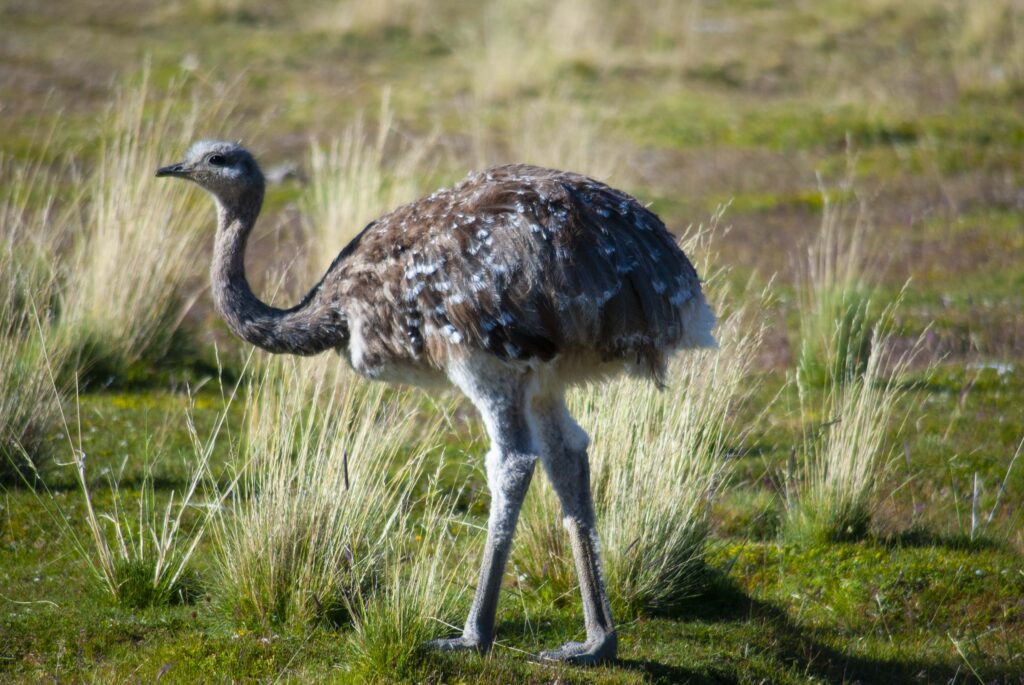
Dote on dazzling Darwin’s rheas
Is that an ostrich running across Patagonia’s elevated grasslands? No! It’s Darwin’s rhea – or lesser rhea – a smaller cousin to the ostrich and emu. Native to Patagonia, this flightless bird stands about 1.2 metres tall (4 feet) and is South America’s biggest bird. Its distinct feathery plume, elegant long neck and expansive wing display are impressive enough; if you’re lucky to see it in full sprint, expect to be wowed.
Chile’s Patagonia National Park is a great place to see this endangered bird, as a new flock was introduced there in 2020 to help with dwindling numbers. While there are no Patagonia predators for this flightless bird, pesticides and habitat loss have proven formidable threats. You’ll often see Darwin’s rhea hanging with guanacos in perfect harmony.
Admire Patagonia’s armadillos
Translated to ‘little armoured one’, armadillos are the only mammal in nature to have distinctive armour. This makes sighting one a real treat while seeking animal life in Patagonia. These creatures are seen around spring and autumn in Chile’s Magallanes and Aysén regions, as well as in the spectacular Torres del Paine National Park.
The pichi or dwarf armadillo is a solitary critter that wanders in small bushes on sandy soil by day. In search of a feed, dwarf armadillos love insects, worms, rodents and lizards. You can generally spot them by their yellow-edged dark brown shell; however if it’s winter, the dwarf armadillo burrows deep to hibernate.
The Patagonia armadillo, also known as the hairy armadillo, is nocturnal in summer only. The ‘hairy’ moniker comes from the long hair between its plates. The most prevalent armadillo species in the region, you can witness them in Patagonia’s grasslands, forests and savannahs.
Marvel at maned wolves
Looking uncannily like a fox on stilts, the maned wolf is a unique canid found in parts of South America. This includes some of Patagonia’s protected regions where the maned wolf thrives in the diverse ecosystem of forests, steppes and wetlands.
While an elusive, solitary Patagonian animal to spot (especially without an expert guide), if you know what you’re looking for, you can increase your chances. Its long reddish-brown coat covers a sleek body with a thick black mane around its neck. Their skinny legs give them extra height to around a metre (3 feet) tall, while their high-pitched roar-bark helps them communicate with other maned wolves.
The maned wolf is one of the most skilled predators in Patagonia, deploying a four-legged jump-pounce to flush out their prey. As omnivores, maned wolves like small mammals, birds and reptiles in addition to plants, fruit and vegetables.
At Sea
If you think the animals that live in Patagonia are limited to its vast and unspoilt land, think again. At sea, your “oohs”, “aahs”, and “wows” will be just as prevalent as on land, with countless marine mammals and sea birds plying the waters off Patagonia’s coast.
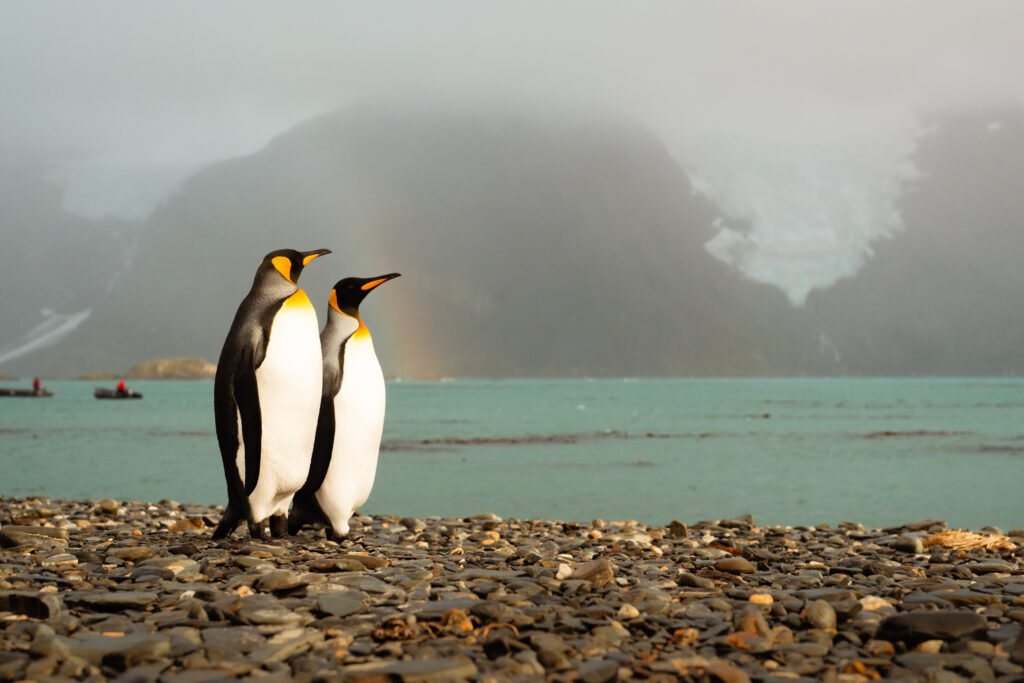
See penguins at play
Did you know there are more penguins in Patagonia than people? This is mainly in part due to the colossal numbers of magellanic penguins – there are around one million pairs! With over 60 magellanic penguin colonies along the Patagonia coastline, observing these small tuxedoed penguins waddling, fishing and nesting is an absolute delight.
Almost wiped out by European whalers, king penguins are making a comeback in Tierra del Fuego. About three times the size of a magellanic penguin, the bold orange cheeks of king penguins are bound to catch your attention if you spot one.
If you’re lucky enough to witness the southern rockhopper penguin – a cliffside dweller made famous from the Happy Feet movie – it might also pay to grab a lottery ticket when you return home. While there are 30,000 rockhoppers in a colony, they are normally only found on very difficult-to-access islands. Puerto Deseado, a fishing port in Argentine Patagonia, is your best chance to spot one in the wild. Recognise them from their red eyes, yellow brows and of course that adorable hop.
Humboldt and gentoo penguins also call Patagonia home – around 14,000 Humboldt penguins call Southern Chile home, while gentoo penguins, who breed in smaller colonies, can are found on Hammer Island, off the Argentine coast.
Soak up time with sea lions
The South American seal lion is a playful and charismatic mammal residing along Patagonia’s rocky coastline. Whether they are swimming with grace, performing acrobatics or boisterously engaging within their colonies, it’s always a treat to witness them.
Argentina’s Peninsula Valdés is a UNESCO World Heritage site and one of Patagonia’s top wildlife destinations, where you can walk or kayak among the 500-or-so seal lion rookeries, also known as harems. During the breeding season (December to February), its beaches are chock-full of fertile females and gregarious males competing and marking their territory. Around 130 females make up a harem, with the dominant bulls impregnating most of the rookery. Pups are usually birthed 350 days later.
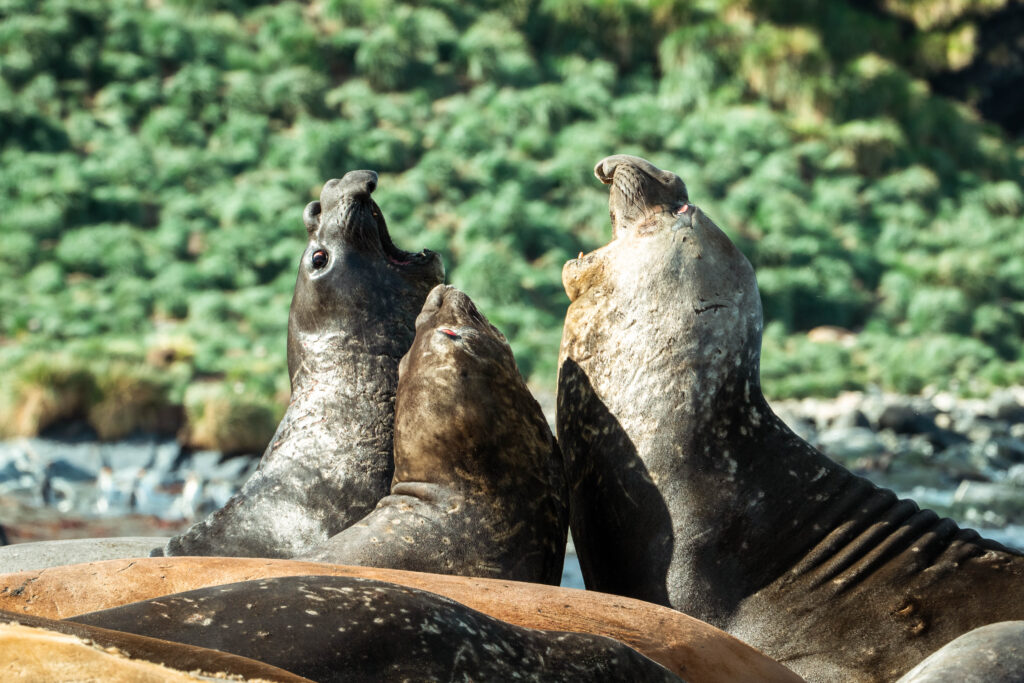
Spy southern elephant seals
Get close to the world’s largest seals, also found in Argentina’s Peninsula Valdés. The southern elephant seal can reach up to six metres (20 feet) in length, and males can weigh in at a solid four tons. Eight times larger than a sea lion, the southern elephant seal is an intimidating force, especially with their trunk-like noses (hence the name) and willingness to go into battle for total dominance.
Like the sea lion, the female southern elephant seals hang in harems and are also polygynous. While smaller than males, the female southern elephant seal is still impressive, weighing around 1.5 tons. Their gestation period is 7-9 months, and after giving birth they’ll nurse for around three weeks before leaving their young to go on an extended foraging trip for two months. Despite the deafening cacophony of the harems on the beach, each mother can easily identify their baby through sound and smell cues.
Get wowed by whales
There are four whale species that spend time cruising Patagonia’s frigid waters: the southern right whale, humpbacks, blue whales and orcas. And yes, we know orcas are technically dolphins. However, as they are as big as a bus, we think they fit into this category quite nicely.
One of the friendliest whales at sea is the southern right, a curious breed that loves to get close to our purpose-built expedition ships. Majestic and graceful, they glide the southern waters during their breeding season (June to November).
Witnessing a humpback breach is another pinch-me-moment you may be fortunate to experience. As is seeing a sociable and active orca – especially if we catch a pod doing what orcas do best: working as a team to stalk, corral and catch prey!
Upping the wow factor is the less common sighting of a blue whale, the world’s largest animal. You’ll certainly see a blue whale coming – they can reach up to 33 metres (110 feet) in length – yet they are elusive thanks to a smaller population. Spotting a blue whale on one of our Patagonia cruises would without a doubt be the highlight, period.
In The Air
When travelling through Patagonia, be sure to pack your binoculars, as there are over 460 bird species that call this avian paradise home. Whether it’s a swooping bird of prey, warbling forest birds, or stealth gulls snatching their dinner from the waves, there’s plenty to see in Patagonia’s skies.
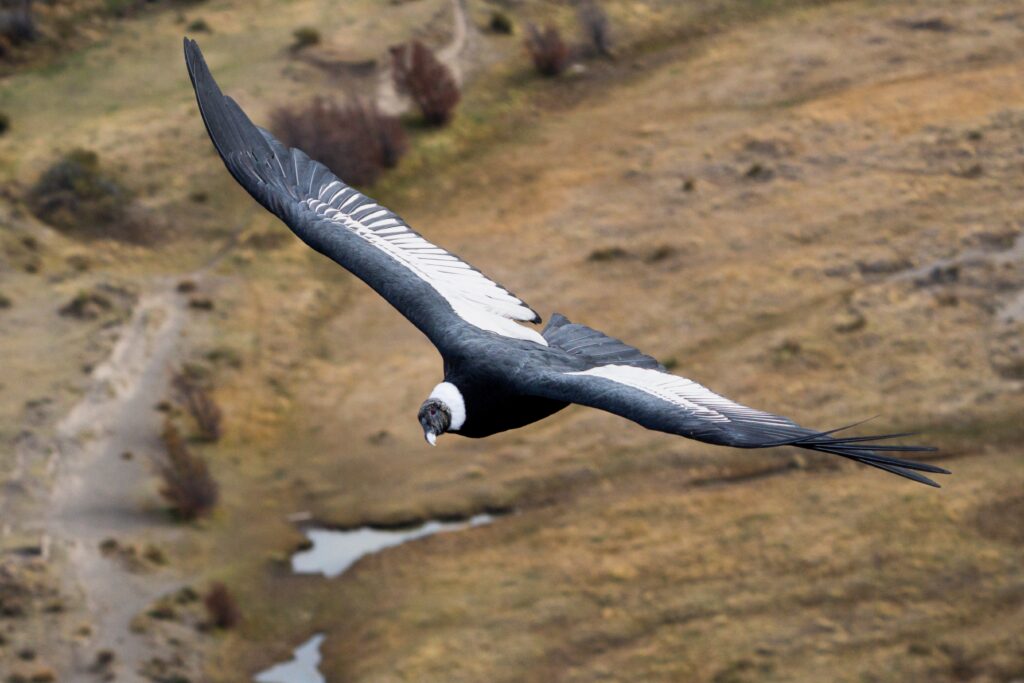
Appreciate amazing Andean condors
The Andean condor is the most magnificent bird swooping, soaring and gliding in the Patagonian skies. This iconic bird of prey, one of the world’s largest flying birds, sets an impressive sight, thanks to its colossal wingspan, which can reach up to 3.2 metres (10 feet). With a large black body, expansive grey wings, and its tell-tale white collar, spotting a condor is an exhilarating moment on any trip to this special part of the world.
The protected Andean condor is easiest spotted when touring the mountainous regions, including Torres del Paine National Park in Chile. Perhaps you’ll see one on our Patagonia Discovery Trek? The mountain landscape, high altitude, and wide-open spaces offer the ideal habitat alongside the powerful thermals that facilitate their graceful flights.
Observe austral pygmy owls
Spot the diminutive austral pygmy owl in Argentina’s Tierra del Fuego National Park, thankfully during daylight hours. Only 18-20 centimetres (7-8 inches) tall, its striking yellow eyes, intricate feather patterns and tuft-less round head help it blend into the forest background.
Luckily, the austral pygmy owl’s distinct call helps visitors notice the bird perched atop woodland branches as it patiently waits for a small rodent or bird dinner. Listen out for its high-pitched whistles that sound like a blend of a squeaky door and kitten mewl.
Cherish time with Chilean flamingos
The vibrant pink plumage of the Chilean flamingo makes for a striking contrast against Patagonia’s Aysén and Magallanes landscapes. Here, they enjoy the spoils of brackish lagoons, lakes and salt flats, using their bills to filter as they feed.
While one flamingo is enchanting to see, the large congregating flocks during the breeding season (from December to February) are mesmerising! As a collective, the colonies raise the flaminglets until they can fend for themselves. Born pale, baby flamingos’ distinctive pink colouring develops from the algae and small crustaceans they feed on.
The indigenous people of the Andes hold a special reverence for flamingos, believing them to be reincarnations of good souls.
Ready to spot wildlife for yourself?
As if Patagonia’s incredible landscape wasn’t alluring enough, you can now see why an expedition cruise or trekking tour to Patagonia is a must for any nature-loving traveller. From pint-sized species to gigantic blue whales, an Aurora Expeditions trip offers countless ways to spot wildlife in Patagonia. To book your place, contact our friendly experts or your preferred travel agent.
Not sure whether to cruise or trek Patagonia? We’ve got four great reasons why trekking Patagonia might suit, along with 10 trekking highlights!
Antarctic Explorer featuring the Chilean Fjords
Polar Expedition
Welcome to Aurora Expeditions’ Antarctic Explorer featuring the Chilean Fjords Fly/Sail expedition. Early Antarctic explorers returned from their voyages to the deep south with tales of a magnificent, ice-covered land teeming...
14 Days
From USD $16,796.00/pp
Patagonia Discovery Trek (Argentina Return)
Trekking
Welcome to our Patagonia Discovery Trek expedition. Discover the vast Patagonian wilderness on this unique guided walking trip, taking in two of Patagonia’s most iconic national parks and the famed Perito...
10 Days
From USD $5,795.00/pp
Patagonia & Chilean Fjords
Polar Expedition
Welcome to Aurora’s Patagonia and Chilean Fjords expedition. Sail the legendary Beagle Channel and marvel at the snow-covered peaks of rugged Patagonia. Zodiac-cruise through fjords flanked by glaciers and watch as...
15 Days
From USD $12,915.75/pp




